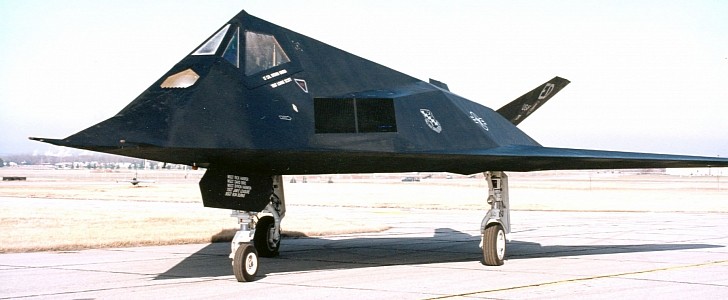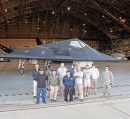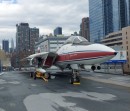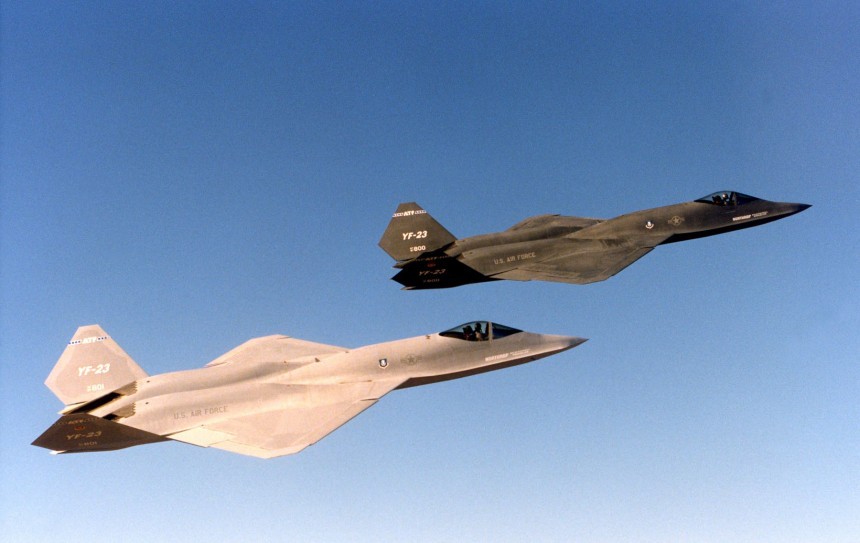You'd think that the United States Air Force and Navy both have access to whichever jet aircraft they please. We're sure the U.S. Military would like to believe this is the case. But sadly, it's a bit more complicated than this. Let us show you why.
A few spectacular airplanes have slipped through the cracks of military funding over the last 30 to 40 years alone. Just for a laugh, let's take a look back at some recent American jet prototypes their military is beating themselves up over letting go of.
The prototype stealth fighter was developed in conjunction with McDonnell-Douglas, makers of the F-18 and F/A-18 Super Hornet. It would be a vast understatement to say the many military personnel on sight were impressed with the team's work upon its first test flight in the summer of 1990. The twin-engined fighter had the radar signature of a small bird compared to the airplane-sized blip a fighter like an F-16 or F-15 would register on modern radars.
Its twin General Electric YF120 afterburning turbofan engines jetted 35,000 pounds (156 kN) of thrust, each with a full afterburner, could propel it well past twice the speed of sound. Its sophisticated internal weapons bay could carry a more varied cache of weapons compared to that of that elephant in the room we won't namedrop
just yet.
It could carry, potentially the B61 nuclear bomb. A weapon that wouldn't fit inside the YF-23s competitor's weapons bay until its operational variant was already in service years later. That could be because Lockheed Martin never bothered to propose it, granted. As the Raptor was an air superiority fighter first, and a decent stealthy bomb truck a very distant second after all. Just look at how out of place it looked strafing bomb targets over Syria a few years ago.
In truth, just about any jet fighter could theoretically carry a nuke. But at the end of the day, none of that was enough for American Armed Forces to get over their long-standing beef with Northrop stretching back to its days building experimental flying wing bombers in the 40s and 50s. It was enough of a grudge to let the less spectacular but still very capable Lockheed-Martin F-22 Raptor get the green light instead.
Unlike the YF-22, the YF-117 was designed from the word "go" to carry a wide array of bombs, the B61 included. But it did not carry a cannon, could not really defend itself when under attack from fighters, and was at least somewhat vulnerable to Soviet surface-to-air missiles. But outside of those areas, the Nighthawk was a superb stealth attack aircraft.
When the raw, brute force of the A-10 Warthog would not be conducive to swift victory, the F-117A could swoop in, drop heavy ordinance, and fly away like they were never even there. It may have been pig slow compared to a Raptor, but there are added benefits to no afterburners in the dead of night. We need not elaborate.
Officially, at least the F-117A was retired in 2008. But Nighthawks have been seen flying over the skies of Nevada and California as recently as 2021. It's as if the military was trying to use body language to tell us all something. Seems like they really do want it back.
Many people in aviation circles pin this retirement down to things like the F-35 Lightning Joint Strike Fighter team bullying the now merged Northrop Grumman into giving the JSF all the real estate on Navy carriers. Others had it pinned down to a squadron of F-14s being exported to the Shah's Iran in the late 70s about 30 or so seconds before a nationwide revolution installed a vehemently anti-western government.
If any upgrades were to be added to the Tomcat's American airframe, chances are good Iranian espionage could bring the technology right into their hands. Whatever the case may be, jet junkies in civilian and military circles still hang on to some hope that the iconically sexy Navy fighter returns to the battlefield in some capacity. To that, we say this. It's been 15 years now. It's time to move on.
Northrop YF-23 Black Widow II: Better Than The Raptor? Very Possibly.
Northrop and Grumman had yet to merge into the monolithic Northrop-Grumman military-industrial giant it is today. Initiated under the controversial Northrop Corporation of LA County, California, in the late 1980s, it's said that the YF-23s biggest weakness was the bad reputation that its parent company carried with it in the late 80s.The prototype stealth fighter was developed in conjunction with McDonnell-Douglas, makers of the F-18 and F/A-18 Super Hornet. It would be a vast understatement to say the many military personnel on sight were impressed with the team's work upon its first test flight in the summer of 1990. The twin-engined fighter had the radar signature of a small bird compared to the airplane-sized blip a fighter like an F-16 or F-15 would register on modern radars.
Its twin General Electric YF120 afterburning turbofan engines jetted 35,000 pounds (156 kN) of thrust, each with a full afterburner, could propel it well past twice the speed of sound. Its sophisticated internal weapons bay could carry a more varied cache of weapons compared to that of that elephant in the room we won't namedrop
just yet.
In truth, just about any jet fighter could theoretically carry a nuke. But at the end of the day, none of that was enough for American Armed Forces to get over their long-standing beef with Northrop stretching back to its days building experimental flying wing bombers in the 40s and 50s. It was enough of a grudge to let the less spectacular but still very capable Lockheed-Martin F-22 Raptor get the green light instead.
Lockheed Martin F-117A Nighthawk: A Spicy, Stealthy Tortilla Chip
It's easy for people to think Lockheed Martin was just fooling us all when the F-117A Nighthawk first saw the light of day. Not only did it not look capable of powered flight, but it was also ugly, very, very ugly. Not to mention it's less of a fighter aircraft than a Harley Davidson Chopper is like a Ducatti Superbike. I.e., not at all, even in the slightest.Unlike the YF-22, the YF-117 was designed from the word "go" to carry a wide array of bombs, the B61 included. But it did not carry a cannon, could not really defend itself when under attack from fighters, and was at least somewhat vulnerable to Soviet surface-to-air missiles. But outside of those areas, the Nighthawk was a superb stealth attack aircraft.
Officially, at least the F-117A was retired in 2008. But Nighthawks have been seen flying over the skies of Nevada and California as recently as 2021. It's as if the military was trying to use body language to tell us all something. Seems like they really do want it back.
Grumman F-14D Tomcat: Foiled By the F-35 and the Iranians
It would probably be a pretty big conflict of interest for the U.S. Navy if it were to bring the Grumman F-14D Tomcat back into service hypothetically. Not the least bit because the model was due to be upgraded to the new Super Tomcat 21 spec sometime in the early 2010s. But this changed in September 2006, when the type was retired.Many people in aviation circles pin this retirement down to things like the F-35 Lightning Joint Strike Fighter team bullying the now merged Northrop Grumman into giving the JSF all the real estate on Navy carriers. Others had it pinned down to a squadron of F-14s being exported to the Shah's Iran in the late 70s about 30 or so seconds before a nationwide revolution installed a vehemently anti-western government.









